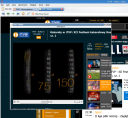DRI PRIME
Multiple graphic cards accessible from Linux:
$ glxinfo |grep -i renderer
OpenGL renderer string: Mesa DRI Mobile Intel® GM45 Express Chipset
$ DRI_PRIME=1 glxinfo |grep -i renderer
OpenGL renderer string: Gallium 0.4 on AMD RV620$ xrandr –listproviders
Providers: number : 2
Provider 0: id: 0x83 cap: 0xb, Source Output, Sink Output, Sink Offload crtcs: 2 outputs: 3 associated providers: 0 name:Intel
Provider 1: id: 0x54 cap: 0xd, Source Output, Source Offload, Sink Offload crtcs: 2 outputs: 3 associated providers: 0 name:radeon
$ xrandr –setprovideroffloadsink 0x54 0x83
$ xrandr –listproviders
Providers: number : 2
Provider 0: id: 0x83 cap: 0xb, Source Output, Sink Output, Sink Offload crtcs: 2 outputs: 3 associated providers: 1 name:Intel
Provider 1: id: 0x54 cap: 0xd, Source Output, Source Offload, Sink Offload crtcs: 2 outputs: 3 associated providers: 1 name:radeon
Google for more.
